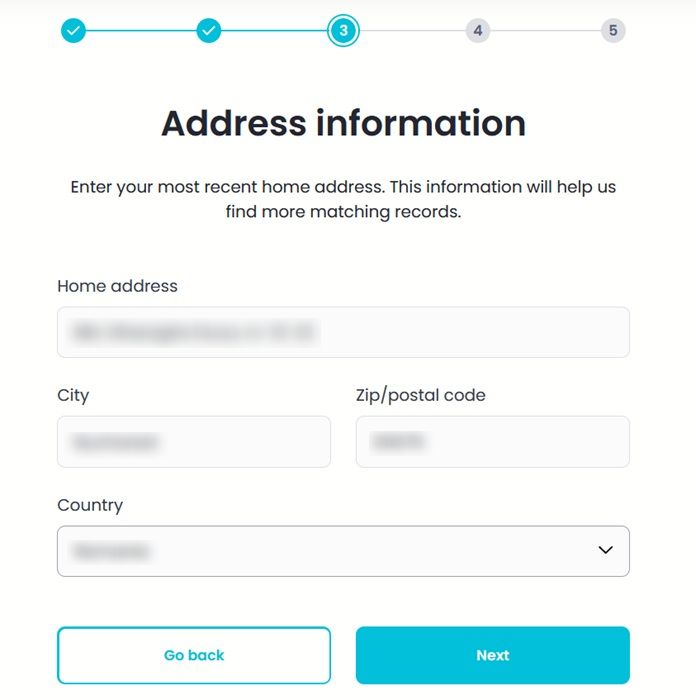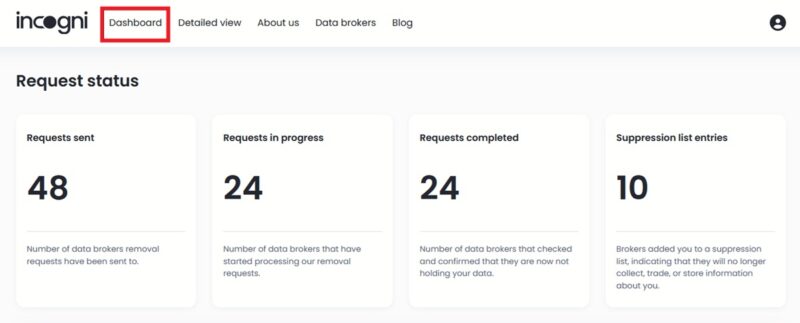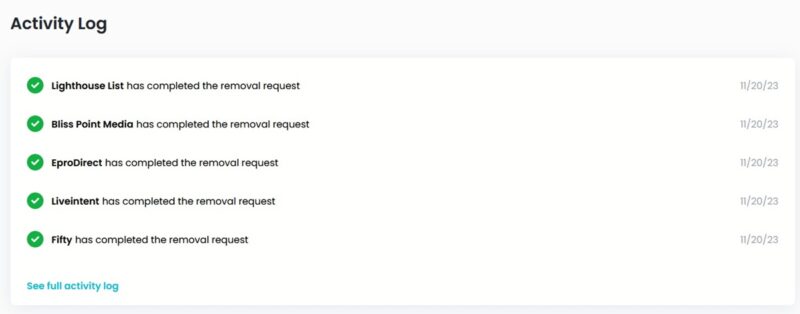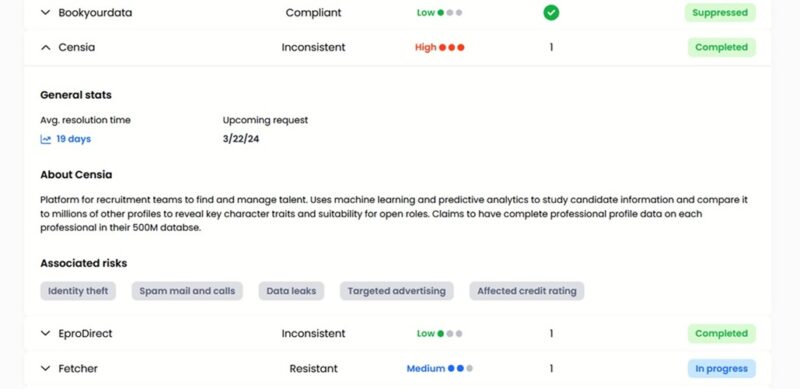
Pros
- Requires little to no action on your part
- Provides weekly updates on the data removal process (via web browser)
- Easy-to-navigate minimalist interface
- Supports data removal from people search sites
Cons
- No free trial
- No way to know whether data has been removed
Known for its robust VPN service, Surfshark has recently expanded its portfolio with a new solution targeting a slightly different security niche. Incogni has arrived on the market at a time when user awareness regarding personal data protection is at an all-time high, promising to offer an easy way to remove your private information from the Internet. We had the opportunity to test this service for this review.
This is a sponsored article that was made possible by Incogni. The actual contents and opinions are the sole views of the author, who maintains editorial independence even when a post is sponsored.
Why Incogni?
In the digital age, your private information no longer belongs to you. Ironically, this has almost become a fact of life that we all need to accept. As you engage in even the simplest online activities, such as accessing a website or searching for something, entities known as data brokers can harvest your information. These are companies that gather, analyze, and sell personal information and data about individuals to other businesses or third parties (which can include governments, banks, and more).

You may have unintentionally granted these data brokers the right to collect your data when you were registering for a service.
Data brokers use all this information to build your shadow profile, which, once sold or rented (as part of a bigger database), will make you a prime target for spam email, telemarketing, and targeted ads. In more extreme scenarios, the exposure of this “leaked” data could result in loan denials, higher insurance rates, and an elevated risk of identity theft.
To prevent this, you can personally request that your data be removed. Unfortunately, this is an endeavor that can consume considerable time. Not to mention that some data brokers are resistant to such requests.
This is where Incogni comes into the equation. It will proactively negotiate with data brokers on your behalf, ensuring the removal of all your private information from the Web, without requiring significant effort on your part.
Starting Your Journey with Incogni
First, you’ll need to sign up with an account on the Incogni website – no app or software installation required. For optimal results in removing all data related to your person, make sure you provide accurate information. This includes the email you customarily use to sign up for stuff, full name, home address, ZIP code, etc.

Finally, you’ll need to sign a form that authorizes Incogni to use the information you provided to send data removal requests to data brokers. Creating an account will take less than two minutes and you shouldn’t encounter any hurdles.
After you’ve set up your account, sit back and let Incogni do the work for you. Please note that data brokers have a specified time frame to respond (30 to 40 days), so the process may not be immediate.
How Does Incogni Work?
Imagine you wanted to initiate the process of removing all your private data from the web yourself – you wouldn’t know where to start! That’s what makes Incogni such a convenient solution. Relying on its robust databases of data brokers, it can start sending out requests within minutes of you signing up.
Based on the details you’ve provided during the signup process, Incogni will contact companies that are most likely to have your information. How does it convince them to give up your data? The company leverages privacy laws – such as GDPR, CCPA, and the PIPEDA – to compel data brokers to remove your personal information from their databases.
This tactic is usually quite effective in getting data brokers to comply, but not all are as accommodating, as you will see in the next section.
Types of Data That Incogni Removes
Incogni targets for removal of various types of data, including:
- People search sites – recently added, Incogni can now remove user data, including profiles, contact details, and background information from more than 60 websites.
- Marketing – this includes browsing habits, past purchases, and general interests. Advertisers can use this to deliver surprisingly accurate personalized ads.
- Recruitment – includes personal employment information. This type of data can power background screening services to HR offices.
- Risk mitigation – includes background, criminal, property, and other information. Can be used in assessment reports to various investment and business companies.
- Financial – includes personal finance and background information. Can be used by credit companies or banks to build shadow credit scores.
- Health information – includes general health data. Advertisers can use this data to target you with health product ads.
Viewing Results in the Incogni Dashboard
According to the company, it takes about a week after signing up for the first brokers to start responding to requests. Viewing this information is a piece of cake, thanks to Incogni’s minimal interface.
Click on Dashboard to view at-a-glance information regarding the data removal process.

You can view the number of data removal requests sent on your behalf and the number of requests that have been completed. In 10 days, Incogni sent 48 requests on my behalf. Almost half of the contacted data brokers confirmed they’ve deleted and aren’t holding my data anymore. Another 10 added me to a suppression list, meaning they no longer collect my data.
For a quick overview of the recent activity, you can check the Activity Log for new notifications. These are generated once data brokers complete the data removal process.

Incogni will periodically send you emails containing updates, which is really handy, especially if you tend to forget to check your inbox. You’re prompted to log in to Incogni for more details.
Take a More In-Depth Look
For additional information, click on the Detailed view button. Incogni displays the status for each request, showing In progress/Suppressed or Completed – depending on the case.

You can also check the Severity status for the data collected by each data broker. This is calculated based on the level of sensitivity and associated risks of the information held.
In my case, Incogni assessed the Severity score for data held by recruitment and talent management platform Censia as High. This is a company that uses machine learning and predictive analytics to study candidate information and compare it to millions of other profiles to showcase key character traits and suitability to open roles. Looking around on their website, I found that Censia openly acknowledges its reliance on data brokers.

Incogni also gives a compliance score to each data broker, depending on how cooperative they were following the request to remove your information. This can range from Compliant or Inconsistent to Resistant.
For more information regarding a particular data collector, click the drop-down arrow next to their name. Here you can view details regarding that broker and the associated risk you might experience following data collection. In the case of Censia, these are:
- Identity theft
- Spam mail and calls
- Data leaks
- Targeted advertising
- Affected credit rating
Incogni also lists when the next request for cleaning out data is due. The average resolution time is also provided. This varies depending on the data broker.
You can filter through results if you don’t want to browse through all of them. Incogni can show you brokers based on Compliance score, Severity score, or Request status.
It’s worth pointing out that unless you contact data brokers or check their websites, you can’t be 100 percent sure that your data has been deleted. Incogni doesn’t provide a way to verify that. But even if you reach out, you still may not get the proof you need to confirm.
What About the Data Incogni Collects?
Incogni does some data collection of its own, so it’s fair to ask: what happens to that data? According to their Privacy Policy, Incogni does not sell your personal information. However, the company does share it with company partners who help it deliver the service. This includes entities such as analytics service providers, like Google LLC, or marketing service providers, such as Mailchimp and Tune Inc. Yet, the company notes that you can request the deletion of your private data or ask to restrict the processing of your information.
Incogni may also share your data to comply with applicable laws and regulations, such as responding to a subpoena, search warrant, or other lawful requests. Finally, Incogni says it will ensure the protection of your privacy rights in case of transferring your data outside the European Economic Area (EEA.)
Incogni Pricing
Incogni is a paid service that does not offer a free trial. Fortunately, plans are affordable enough, even if you’re looking to give it a go for curiosity’s sake.
- Monthly plan: $12.99 per month
- Annual plan: $6.49 per month (billed $77.88)
Wrapping Up
Overall, Incogni stands as a valuable tool for safeguarding your digital identity. As online privacy concerns continue to grow, Incogni’s bold approach offers a protective and effective means for users to navigate the digital landscape with ease and confidence.
While I appreciated Incogni’s simple interface that doesn’t drown you in countless features, a few extra security options might have been nice to have. The service also doesn’t yet support adding multiple email addresses per account – at least at this point. But given Incogni’s low price tier, that’s not surprising.
Image credit: Freepik
Our latest tutorials delivered straight to your inbox